Water is the most critical resource for humans aside from shelter, and we can only survive around three days without it.
The problem with water is that most of the freshwater we find in our environment holds the potential to harbour dangerous pathogens.
Therefore, it is critical that we have the ability to purify any water that we find to render it safe for us to drink.
Disclaimer
The water purifier that I am going to detail here has not been laboratory tested and should only be built and put into use in an actual SHTF situation.
This water purifier relies on the water to be heated to a point in which pathogens would be killed, and failure to achieve this will render this water purifier ineffective.
Related: Survival Water From Your Water Heater
You, the reader, assume all risks in the construction and use of this purification system.
How This Water Purifier Works
The water purification system that I am about to describe employs a two-stage filtration.
The first stage uses cotton balls, sand, gravel, and small river rocks to filter debris and sediment from the water with a layer of activated charcoal to bind to toxins and chemicals.
After this stage, the water passes through a heated copper coil, which heats the water to boiling, killing all pathogens in the water. The combination of both stages should render most water safe to drink.
What Will the 20 Dollar Water Purifier Remove?
The first stage of filtration will remove a lot of foreign matter from the water, making it look much clearer.
The sand will also help filter out some bacteria, parasites, and other pathogens but not enough to render the water safe to drink. The activated charcoal will bind with chemicals and toxins with the added benefit of making the water taste much better.
The second stage of the purifier is designed to bring the water passing through the copper tube to the boiling point, killing any pathogens in the water.
Therefore, it is essential that the water that exits the copper coil be very close to 100 degrees Celsius at sea level, because this is the only point you can confirm that the process is working.
Building the Twenty Dollar Water Purifier
Most of the items you will need for this build are probably lying around your home or garage, with the only pieces needing to be purchased being the flexible copper pipe and the activated charcoal.
I was able to put this together in less than an hour, and the process was relatively straightforward, requiring only basic tools and knowledge.
Related: Disinfect Huge Amounts Of Water With This Common Household Item
Tools Required
- Drill and drill bits
- Saw
- Scissors
- Epoxy
Materials
- Sand and gravel
- Cotton balls
- Activated charcoal
- Flexible copper pipe
- 2×4’s and screws
- Alcohol stove
- Soda bottles
Instructions
1. Cut the bottom off the soda bottle, then drill a hole into the cap that is large enough to provide a tight fit around the copper tubing.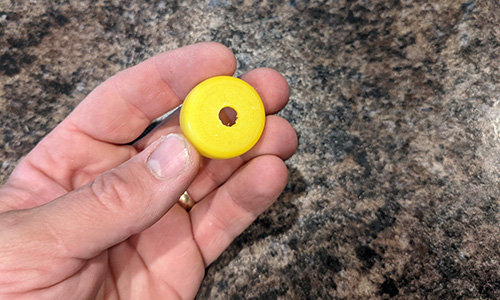
2. Wind the copper tubing into a coil. The tighter the coil, the more effective you will be able to heat the water to boiling.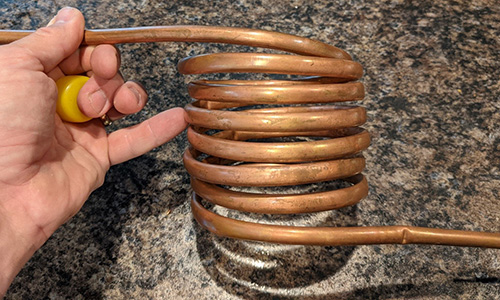
3. Bend the upper end of the coil up at 90 degrees.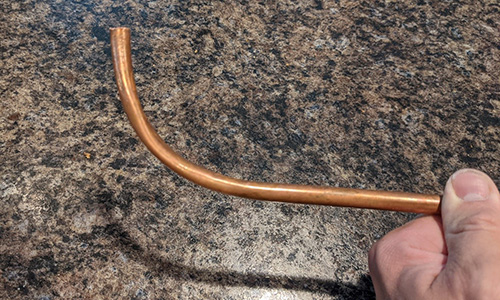
4. Bend the lower end down slightly to facilitate filling a container with clean water.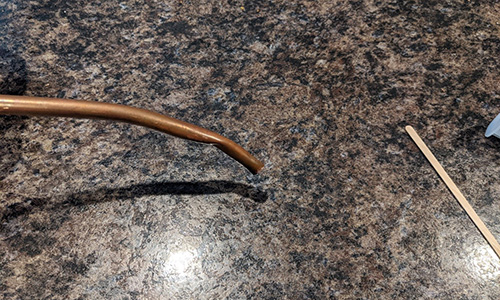
5. Place the cap onto the copper pipe.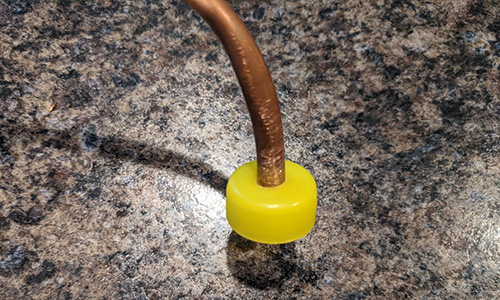
6. Epoxy the cap to the pipe to prevent leaking.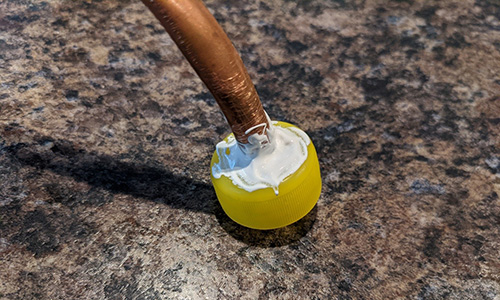
7. Build a frame to hold the coil high enough that you can place a stove underneath it.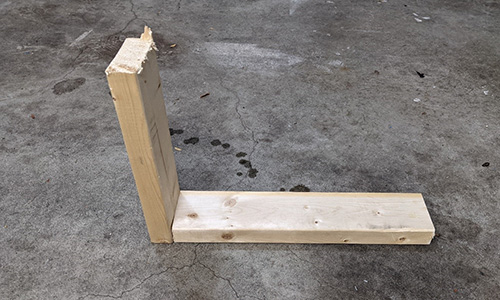
8. Attach the upper end of the coil to the frame. Either use metal stapping or screws. It must be secure enough that the first filter stage will not rotate or spill when full of filter media and water. I was able to accomplish this with only a few screws, but you may need to use other more secure methods.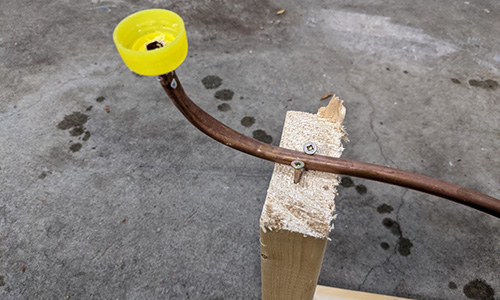
9. Place the stove underneath the coil.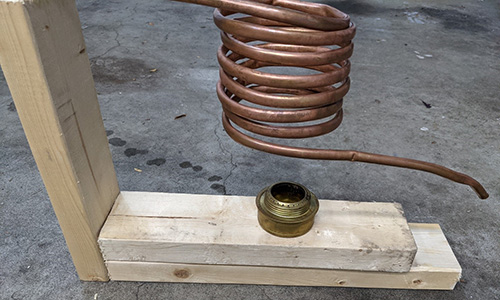
10. Place cotton balls in the neck of the soda bottle.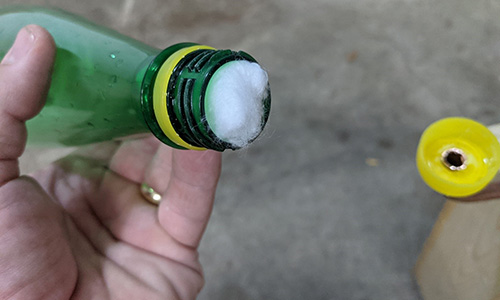
11. Screw the soda bottle onto the cap.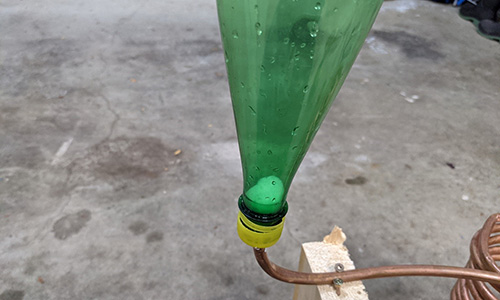
12. Place the activated carbon, sand, and gravel into the soda bottle in layers.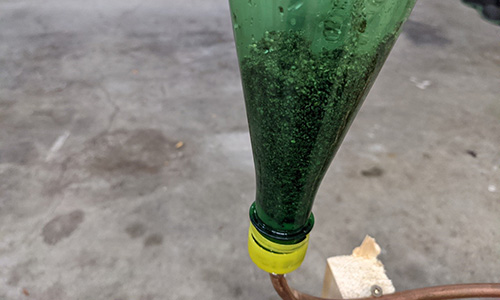
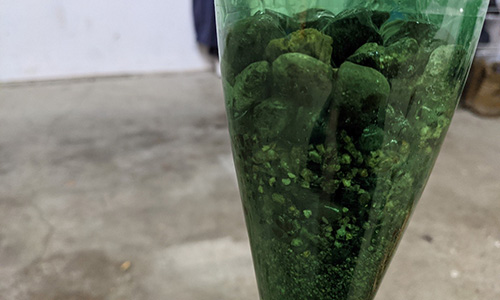
13. Light the stove.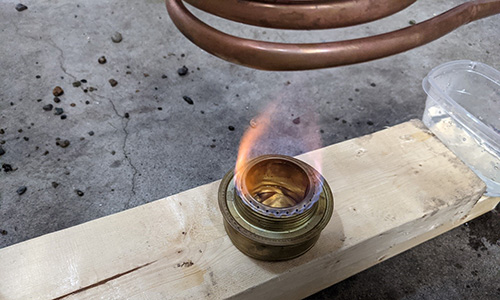
14. Pour water into the first filter stage and check the temperature of the water coming out of the other end.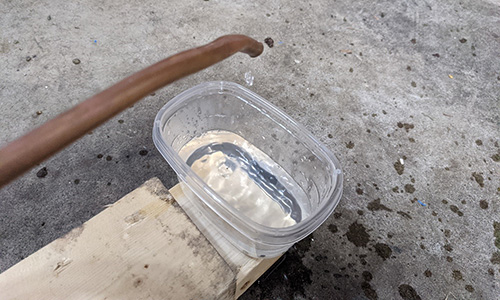
15. When the water coming out is boiling hot, you can place whichever bottle you wish at the outlet to capture the clean, purified water.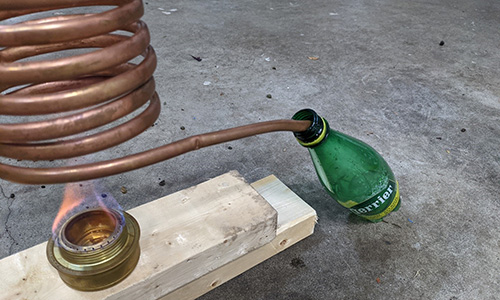
Related: How to Supplement Your Potable Water Supplies by Cheaply Harvesting Rainwater
Points to Note on the Twenty Dollar Water Purifier
- You can use a large can to hold the coil and stove, which will increase the amount of heat that will be put into the coil.
- The copper coil could also be wrapped around the stove pipe of a wood stove.
- In my case, I did not coil the copper as tight as I should have, but I could still get good results from the system. So I would suggest coiling the copper as tightly as you are able.
- Adjust the position of the stove until you get the best results.
- To prevent kinking in the copper tube, fill the tube with sand and seal off both ends. This will provide support for the tubing walls, preventing them from collapsing during the bending process.
- When fabricating the copper coil, it helps to have some sort of form to coil the tubing around. Pick a cylindrical object of similar diameter as the stove that you are going to use. PVC or ABS pipe, water bottles, or canned food are all excellent options.
- If you do not have an alcohol stove, you can make one or use whichever stove you have available. Do not use a wood-burning fire because it will not give out a consistent level of heat.
The two-stage water purification system that I have detailed here is a good option for an emergency situation where all of your other water filtration and purification options have been rendered useless or no longer available.
However, while it will work well in theory, it is worth mentioning again that there is no laboratory evidence as to the level that it will purify water. Therefore, I make no claims as to its true efficacy.
You may also like:
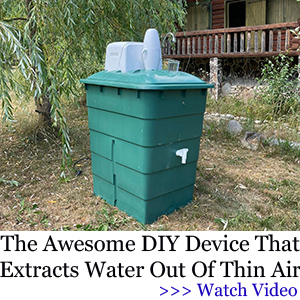 How to Get a Year Supply of Firewood for $10!
How to Get a Year Supply of Firewood for $10!
The Most Sought-After Bartering Items in a Crisis (Video)
Whatever You Do, Don’t Chop Down This Backyard Tree

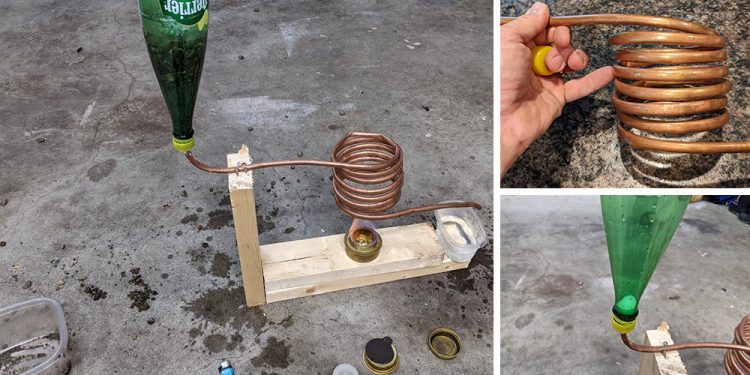













Interesting so how does the heat from your stove not rise up that copper pipe to melt that epoxy and plastic lid?
A effective water filter for carbon filtering REQUIRES Contact Time. Simply pouring water through a cotton ball abs layered sand carbon “filter ” isn’t going to do much more than get some dirt out of your water.
Also FLOW Rate and contact time with that heated copper coil ALONG with possible steam Explosion issues is a Real Problem.
That you NEVER TESTED the results Scares this Combat Medic.
Why not SIMPLY filter the crud with a coffee filter Or a couple of clean layers of tee shirt THEN BOIL the water in a pot or even a Teapot?
At least we KNOW water was really brought up to a boil for a measured time.
Totally agree. To filter water and make it pure in this way, it will take much more sand and charcoal. Can you do it that way? Yes, wells prove it. My well is over 200 feet down and is excellent drinking water. I still filter it to lessen the sediments.
Howdy, here, the well water is highly mineraled and comes out in various colors from light orange to black. Using just off-the-shelf water filters, and filtering several times using coffee filters, in time the water is clear and tastes good. The water is also treated with Blessed Salt; with faith our food and water are safe. HTH. You can find blessed salt on some websites or you can go to the nearest Catholic Church and ask the priest to bless your sait, which you bring from home. Using just a grain or two per meal, a box of salt will last a long time. HTH.
Michael: Steam will not burn the glue. Steam carries away the heat, up into the copper where it’s lost. We use to use flour paste on the pot and it never scorched.
Please remember, you can boil water in a cabbage leaf. Why would it explode? If he were cooking mash, yes, then there can be a problem.
Activated carbon loses silver into the steam, which sterilizes it. We use brass cups for camping and brass–copper+zinc–kills about anything known to harm us.
niio
Sorry, Red. I know I am not a thermal transfer expert, but based on touching hot copper the °F temperature of the steam exiting the bottle with the copper tubing inserted into the plastic cap will most assuredly transfer the heat to plastic cap. This is based on 60+ years of inadvertently touching hot copper piping with the resultant rapid withdrawal of the offended hand.
Yes, you can boil water in a cabbage leaf but eventually the leaf will start to dry out and start to scorch and if you touch the leaf you will rapidly withdraw your hand from the hot leaf. Leaf the water in the leaf long enough and the whole thing will collapse due to the cabbage cooking.
The activated charcoal is mostly unaffected by the steam as it is going in the direction of least resistance which is to the opening in the coil. While hot vapor rises, in this case, eventually gravity will overtake the tendency of hot water vapor to rise and there will be no “silver” transfer to the vapor
I’m sorry, but using brass cups for camping is living on the edge. In order to have any bactericidal effect, the water would have to remain in the cups for some undetermined amount of time, depending upon the polluting content of the contents of the cup.
I usually learn a lot from your posts, but I am afraid this time you have struck out at the plate. If you have not experienced intentional problems drinking stream or lake water with brass cups, consider yourself very lucky.
LCC: You’re the best sort of teacher, respected and willing to learn.
Nor am I an expert on thermal dynamics, but learned the old tradition (distilling) from a great-uncle whose family were professionals, till Prohibition made them close the distillery. It’s that copper cools fast that causes condensation. Steam will soften the plastic, but not melt it. all fire is at the far end of the bottle.
https://myhealthoptimizer.com/wp-content/uploads/Using_Vaporized_Colloidal_Silver.pdf
Ah, but put the cabbage leaf in a basket of green twigs, young man.
we take the cups when we go to Mexico. No Toltec-Two-step. If it worries anyone, make coffee or tea in the cups. They’ve found living bacteria in active volcanoes. boiling alone is not perfect. niio
M- Fortunately, great tap water here in the big city is plentiful and service delivery rarely disrupted, but if it is I for one will be following your advise. Thank you!
CC: I love this article. But, for some reason, all those dairy farms in the Adirondacks comes to mind… But! NYC is top model for clean tap water. Farmers are working to prevent Bossy getting close to streams. Your water is good enough, someone was was selling bottled tap water as spring water. It took a lab analisis to tell the difference. If I recall right, the water was too pure to be from a spring. Technically, tho, he was right, all water starts in a spring. niio
Why not just filter it and boil it in a pan
Agree totally. I would be worried that this setup would on occasion pass water without enough heat to kill the bacteria. Also, I am more likely to find or have a container to boil water then to have a length of copper tubing. This described setup, in my opinion, is complex and dangerous.
The way to make Holy Water is boil the he’ll out of it.
Chris: Copper kills bacteria and parasites. Silver in the activated charcoal will do that, as well. Steam will leave behind a lot of toxins. niio
Except copper & silver does nothing for dissolved solids. What with gypsum in it is toxic, unless you distill it, you have to chemically treat it. To do with “guppy water” you have to adjust the pH to drop the gypsum out of the water. Much easier to distill it.
ck: No solids will get into the coil. I live in arizona, gypsum is lime and sulfur. Our soil is 8+Ph, and plants will not root thru caliche (lime) unless sulfur is there to eat holes in it. Gypsum in the water will give a bad case of the trots. niio
Guppy water is what you doing if you want to die of dehydration. Yeah, give you the trots & then some. I used to use a couple coffee filters & some instant ice tea with lemon. Would drop out this yucky grey slime & then it was potable. Amazon may not be here WTSHTF, but they are now, and that’s why I’m getting one now. Just another tool.
Steam will leave behind solids and metals. That’s why with my counter-top distilled water generator I have to clean it out after every batch of distilled water. There is always a lot of gunk left behind after each batch of distilled water. That is city water that meets “federal standards” most of the time. Making a statement like “copper and silver” kill bacteria and parasites leaves too much out. There are parasites that are only killed with a more extended period of boiling. Prions in the water are not killed by boiling as they are not “alive”. I am not enough of a bacteriologist to know if there are bacteria or even viruses that are not killed by boiling. That said, however, boiling or distillation will kill the biggest percentage of harmful pathogens and is our best method of providing safe drinking water after some catastrophic event.
A simple statement like “silver and copper kill bacteria” leaves too much out. For starters, how about how polluted is the water with bacteria. Is it just just packed with typhoid and cholera?
How long does it take the cup to actually kill pathogens in it? Does the amount of zinc or other metals in the copper have an effect on the germicidal potential of the copper?
That sort of open ended statement without delineating the parameters that are critical to every effort to purify water is dangerous and in my opinion, completely without merit. I am surprised that you would post such an unscientific statement.
It’s like saying for some of the herbal remedies, “grab a handful of the leaves”. Whose hand? Your mitt that can grasp a basketball with one hand and turn it upside down and not lose the basketball or the hand of a 5′ tall woman who takes an extra small glove?
As I said earlier, if you have been depending upon your copper cup to provide bacterial and viral protection from untreated water sources, you have been very lucky.
ck: I never heard the term guppy water, but know people can get used to too much lime in the water. the idea behind the article is dyi. We may need the knowledge, but in case we do, we have it. BTW, I was ‘schooled’ how to operate distillery equipment before I was in kindergarten. niio
Red its a typo for gyppy water. Aka gypsum water.
LCC: Herbal medicine isn’t a fly by night thing, but studied for hundreds of generations. Materia Medica listed them. Copper is so strongly antibacterial it’s considered self-sterilizing. https://www.investmentwatchblog.com/copper-kills-99-9-of-bacteria-within-two-hours/
That’s as good as household bleach.
https://www.researchgate.net/publication/244941051_Oligodynamic_Action_of_Silver_Copper_and_Brass_on_Enteric_Bacteria_Isolated_from_Water_of_Kathmandu_Valley
https://www.sciencedaily.com/releases/2013/11/131111091136.htm On zinc
I strongly prefer time-tested against witchdoctors like fouci and gates. For that matter, if you check, you’ll find the entire existence of the AMA was to provide less expensive malpractice insurance to the bumblers in medicine.
India, where they drink basically sewer water.
https://www.sciencedaily.com/releases/2013/11/131111091136.htm
ck: I thought so. Every area has their name for it. niio
This is a very crud way of filtering water, But For some odd reason that you needed to filter some water and had all of these things, then you could see that this set up would be better then NO filtered water at all.
Better then nothing…
So as crud as it may be. I like it.
For someone new to the “Prepper World”, I find a lot of these articles interesting and informative. You give me ideas that have never occurred to me.
I live in the Panhandle of Florida and am really interested in ways to create a “root cellar” in a cost effective and efficient way.
There is at least one article on this list that I remember that dealt with building a root cellar. Unfortunately I don’t believe Claude has a search engine for his website. I think you will have to search manually.
One caveat, in Florida, the water table may be too high to build a root cellar. In some places a very shallow hole hits the water table. That is a good thing in most cases but not in the case of a root cellar.
High water table makes the earth cooling effect of a root cellar a No Go in the south.
HOWEVER you DO Have plenty of sunshine so a well insulated room and a solar-powered A/C would give you the best root cellar in the area.
I would be concerned about depositing water at 100°C into a plastic container. A glass container made of pyrex glass would be a better choice or a Ball or Mason brand jar. I would predict early failure of the copper tube/plastic interface. While I haven’t tested a device such as this, I feel like Michael that is a weak link in the system.
My plan for producing purified water is to filter fresh water through a series of decreasing screen size coarse-screened filters finally working my way down to coffee filters. boil fresh water in an open container to boil off petroleum based products and organophosphates. The the third step is to run that water thus treated through a Berkey filter or other brand large capacity water filter.
The reason for the intermediate boiling in an open container is that in a closed condensing system those products do not get boiled off into the atmosphere but are boiled off into the condensate to continue to contaminate the water. To eliminate those requires an open surface so that they can be boiled off into the atmosphere. I don’t trust home made charcoal sufficiently to rely on it to totally remove those products.
Of course, worst case scenario, sometime second best will have to do.
With salt water, after the preliminary filtering and boiling, I would run the water through a pressure cooker with coiled copper tubing connected to the pressure cookers acting as the condenser and then through the Berkey for the final heavy metal filtration.
In an EOTW scenario, clean drinking water will be our most precious commodity. Tens of thousands if not hundreds of thousands will die from drinking contaminated water. I believe most folks who have not followed disaster preparations don’t realize how marginal our water system is. The “federal standards” are barely sufficient. Increasing the strictness of those standards is vigorously resisted by political bodies who furnish public water as well as the private companies who furnish water. In the PDRK some small municipal water systems had to shut down because they didn’t have the funds to meet the increase in federal standards some years ago. The well water those systems were pulling had become too contaminated by agricultural activity to meet the increased federal standards without expending significant sums of money that the small municipalities just did have.
LCC: that’s partially why for the coil. By the end of the coil, water should be cool enough to drink. niio
Not without some artificial cooling applied to the outside of the coil. Merely running steam through a two or three foot coil, exposed only to air will not cool the steam sufficiently. The water will still be hot when it drops into receptacle.
I buy distilled water from the local water store. They have condensed the steam in the back room and it then goes through piping to the faucets where it is dispensed. Depending on how busy the store has been in selling distilled water that day before I get there, it will range from barely warm if it has been sitting a while to quite warm when I put in in my jugs if it has been a busy morning. That is water that is carefully distilled at 214 degrees F. I had a long, interesting discussion about their distillation system with the manager one non-busy day. They used to have a distiller that raised the water to 219 degrees F but changed it out to one that raises the water to 214 degrees and saved a bundle of money on 4 degrees difference in temperature.
Whodda thunk? They dispense over a thousand gallons of distilled water a day. I don’t know if that has continued due to the plague. That was pre-plague. That’s a lot of water in my book I thought they used gas for the distiller but the manager told me they used an electric distiller. Much like my counter top distiller. The water to the distiller has been treated first by reverse osmosis to help keep the distiller free from contaminants. If you buy R/O water it is cheaper than distilled water. They must get a special rate from Edison. I figured with my cost per kw/h and the time it took me to clean out the pot plus the charcoal filter that had to be replaced, it was cheaper to buy distilled water at .56 a gallon than it was for me to make it at .65 per gallon.
Try pouring just hot water down a copper tube and see how hot that tube gets. If the water is too hot for you to put your hand in, the tube will be too hot for you to touch. That’s just hot water, not live steam.
LCC: Pouring hot water into the coil is not the same. Steam will not do that. My first lessons in distilling were as a preschooler. To clean the coil, which was 20 feet long, boil it, then pour boiling water into it. the water is still hot when it comes out. Water is forced down the coil. Steam is gently pressured, not forced. Yes, for distilling water, I’d want a much longer tube, but in a pinch! niio
Michael Major, you never used this in real life, have you? I can tell you havn’t because you made something that looks fancy smancy, and I can look at it and tell it wouldn’t work. Poor design. Too much labor & materials go into it, it’s not for SHTF scenario. Even in the best of circumstances, it’s junk.
Listen dude, I’ve been in places where we needed distilled water. Just buy one BEFORE the SHTF. Sure is nice to save money, but how much is that money worth if it might cost you or yours their lives? You can go on Amazon and buy a laboratory grade tool for $38 that I guarantee you does the job a thousand times safer than your idea and produces 100 ml, or $113 for a still that can produce 3 gallons.
I realize that in an emergency you likely don’t have the money or the ability to order through Amazon. I know that if you have the materials your suggested for your still, you can put together a much better design that actually works.
CK: the idea is, no Amazon after SHTF, but diy from what you find. niio
Actually, that I covered.
I’m a water well specialists in the State of Texas and am required to know different ways to make our drinking water safe. This illustration’s concept if accurate, however the scenario of actually being isolated with limited resources would put a hamper on the idea of actually finding any coiled copper tubbing in a wilderness setting. It might work if you were in a more civil environment and had access to these materials but as a few others here made note that there is actually a more simple and efficient way to make water safe in that same environment. The apparatus wouldn’t necessarily be dangerous but the actual working success of this contraption would be questionable. I like the idea of the contraption set up more to a water condensation affect for more purity which you almost had right. Nothing wrong with using what you have to make your drinking water safe. This is a good try anyway.
Clifford: Every abandoned car and truck should have copper. That needs to be cleaned very well, but it’s usable. niio
Red maybe I misunderstand your thoughts here. We are trying to Remove Contamination like ah petroleum and you suggest we Use old Fuel lines for the project? That and the sheer joy of “cleaning ” them enough AND figuring out how to patch connect them together seems MUCH HARDER than a simple selection of reasonable clean water a gunk filtering and a boiling teapot.
I am reminded of the scene in Mad Max where some rodent looking guy says “What’s a little Radiation between friends?”.
Folks IF you live where water is so Bad you NEED Specialized Filtering MOVE. There is a Reason dead animals are found around bad water. They are not smart enough to move away.
Michael: I understand you explicitly. My thought was, this is post SHTF. An emergency not something for everyday. 6 months after SHTF, it’s not likely you’ll find gas or oil in a vehicle. Fill a tank with gasoline, let it set out six months. The gas is gone. Lines are dry but dirty. The old man’s family had been in the distillery business for several hundred years in Europe, then a younger son came to the US pre-civil war, and started his in Penna. They did not make garbage, but high end. If an adult helper screwed up, the old man would threaten to shoot him. No, he wasn’t joking. Even during Prohibition, he was getting 25 dollars a gallon for what he called junk brandy, applejack and other things. When you have wealthy politicians eager for your product, you know what you’re doing. Everything was aged in homemade charred white oak barrels. To remove impurities, homemade charcoal was added. As I understand it, activated charcoal will remove contaminators, but it’s advised that after distilling water, it be distilled again. Mad Max has nothing to do with this.
Because coronal mass ejections are so interwoven in our preps, I thought this article from spaceweather.com would prove interesting.
“A trip down memory lane: In 2001, Solar Cycle 23 was peaking and solar activity was very high. Strong flares were a daily occurance. On Oct. 19th, giant sunspot AR9661 erupted twice in quick succession, producing almost identical X1.6-class solar flares. The double blast hurled two bright CMEs toward Earth: CME #1, CME #2.
The first CME took only two days to reach Earth. It was fast and potent. The storm cloud’s arrival on Oct. 21, 2001, ignited a severe geomagnetic storm (Kp=8). Solar wind speeds in the CME’s wake topped 700 km/s, keeping the storm going for more than 15 hours.
In Troutman, North Carolina, Ronnie Sherril witnessed the CME’s impact. “Auroras were visible in twilight even before the evening sky faded to black,” says Sherril, who took this picture at 7:30 pm local time:
“By 10:30 pm the sky had exploded into bright red with yellowish beams,” says Sherril. “What an awesome display!”
Less than a day later the second CME arrived, and it happened all over again. Another 15 hours of strong-to-severe storming ensued. Using data from a global network of magnetometers, NOAA made this record of planetary K-indices during the two-day event:
Red auroras were sighted in Germany, France, Italy, Spain, Australia, Japan, and in the United States as far south as latitude 35N. Remarkably, there were no widespread power outages or satellite disruptions. The Internet functioned normally throughout. It was mainly an aurora show.
Some observers are ready for more. “We are hoping for something similar for Solar Cycle 25, as the sun has recently had a good increase in its activity,” says Bardelli. Indeed, young Solar Cycle 25 is intensifying, but Solar Max isn’t expected for another 3 to 4 years. Until then, browse the Oct. 2001 photo gallery:
I wasn’t into prepping for a CME in 2001. In that uninformed era of my life I was’t even aware of such phenomena. I didn’t witness the Aurora at that time and in October of 2001, the news was still too much concerned with the 9/11 event to report on something as unknown as a CME event. How fortunate the world was that the 15 hours of solar storms didn’t involve any damage to electronic systems. What a turmoil the world would have been in.
I didn’t see the Aurora additionally because 35°N latitude is a slight distance north of Los Angles and I am in that pocket south of 35°N.
I would say to the folks who hope to witness some more X category CMEs, what my Grandmother used to say, “Be careful what you wish for. You might get it.”
It is my fervent hope that I do not experience double X category CMEs in the years I have left to me. It is an experience that I have most definitely scratched off my bucket list.
Well tried Michael,
An even cheaper method is to put a pan of water on a fire.
There are also people who are not so handy to make such a scaffold and/or do not have the possibility to have a copper pipe at hand. There are plenty of people who have two left hands.
Furthermore, to disinfect water, you need to boil the water for at least 3 minutes (at sea level) In your setup, I don’t see that happening.
It seems to me more convenient (and cheaper) to filter water through a number of layers of cotton cloths so that most of the coarse dirt is out and then boil it for 3 minutes. During cooling, any residue may sink to the bottom of the pan. possibly then filter again in a cloth.
Greetings from the Netherlands, Tigron
I agree with the comments of some readers.
but I think that from the suggested configuration we can improve the equipment a lot.
one of them will be interesting in my BOL
I went on line to see just how many heavy metals are presently identified. Oops! There were 81 chemicals on the list of heavy metals. More than half of them I never heard of. There are five on the list that are considered the most commonly encountered and I will reproduce them with the comments about their toxicity.
“Chromium: The two common oxidation states of chromium are 3+ and 6+. The 3+ oxidation state is essential, in minute amounts, for human nutrition. Hexavalent chromium, on the other hand, is highly toxic and is a known human carcinogen.
“Arsenic: Technically, arsenic is a metalloid rather than a metal. But, it is toxic. Arsenic readily binds to sulfur, disrupting enzymes used in metabolism.
“Cadmium: Cadmium is a toxic metal that shares common properties with zinc and mercury. Exposure to this element can lead to a degenerative bone disease.
“Mercury: Mercury and its compounds are toxic. Mercury forms organometallic compounds that pose an even greater health risk than its inorganic forms. Mercury primarily causes central nervous system damage.
“Lead: Like mercury, lead and its compounds damage the nervous system. There is no “safe” exposure limit to either mercury or lead.”
I believe it cadmium that was blamed for the malformation of ducklings that nested in the waters in the San Joaquin Valley and was also blamed for the pollution of wells in that area. I could be wrong in that belief. It has been a while since I read about pollution in the waters of that valley.
Heavy metals are one of the reasons why activated charcoal is used when purifying water. They are not removed by ordinary filtering nor by boiling.
I believe lead is the only one that is slow acting. I believe all the rest will do you in rather quickly. I also understand that poisoning by any of the listed substances is quite unpleasant. Of course, lead poisoning is a euphemism for being shot. With so much copper jacketed and solid copper ammunition these days, perhaps that phrase will pass out of the common vocabulary.
LCC is right, but also fails to mention methyl mercury, which is a bitch to get rid of. My ignorance prevails, but from what I know is Methyl Mercury is more of an alkalyd (?), thus lower boiling rate thus distillation may not help. Clifford should give some input there.
I went on line to see why methyl mercury was stirring up my brain cells. I found this on Wikipedia: “Methylmercury is formed from inorganic mercury by the action of microbes that live in aquatic systems including lakes, rivers, wetlands, sediments, soils and the open ocean. This methylmercury production has been primarily attributed to anaerobic bacteria in the sediment. Significant concentrations of methylmercury in ocean water columns are strongly associated with nutrients and organic matter remineralization, which indicate that remineralization may contribute to methylmercury production.”
I would suggest that followers of this list read the whole Wikipedia article for themselves.
It is informative. I intend to read up on methyl mercury as I have found that is a large hole in my general knowledge bank and is a deficit that I need to correct.
My main water storage is in an above ground pool and 2 galvanized stock tanks. It is pretty organic looking, green and mossy, popular with frogs. To use it I would coarse filter it through cloth, then purify it with Big Berkey.
If I had to get water from one of the local creeks (one of them we call ‘little brown’) I’d be concerned about farm runoff, hydrocarbons and various ag chemicals. In that case filtering and boiling aren’t enough if you need it for long term use, you need to distill it. The simplest way is to fill a large pot with the water after you coarse filter it with cloth. A big stainless or copper bean pot is ideal, I’ve tried this out with a big ceramic dutch oven. Fill the pot and bring it to full boil, boil off about a third of the water to cook off as much hydrocarbon as possible, put a steel rack in the bottom of the pot and float a large glass or steel bowl in the pot. Heat the water just under boiling and put the lid on the pot upside down, most lids are rounded so when upside down the steam from the heated water condenses and runs down into the bowl. Keep the water just under boiling, any chemical contaminant with a boiling point higher than water will remain in the pot, the water in the bowl will be pretty doggone pure. Of course if you have some of that ubiquitous copper tubing you can set up an actual still, the steam in the pot entering the copper coil and condensing out.
JH: I would suggest that with your green and mossy water tanks that you read the Wikipedia article on methyl mercury.
Your suggestion about an upside down lid is well put. I would improve(?) your design by drilling a hole in the lid and inserting the ubiquitous copper coil to assist in harvesting the steam from the boiling pot.
I have yet to determine if methyl mercury can be removed by distillation which is why I am going to spend more time on the internet.
LCC, methyl Mercury is the leading cause of mercury poisoning. The metal mercury itself is totally chill, but when it oxidizes & starts becoming other stuff it becomes a serious toxin.
Michael, much thanks for this. Like me, you’re probably scratching your head of some of these comments. Most do not seem to realize that this is for post-SHTF. No Wally world, no Amazon, but maybe a Farnham’s Freehold in the next town.
If forced from home, i’ll be in the middle of the night and I am not about to try to haul a ton of heavy equipment.
Activated charcoal will filter out most heavy metals. Copper will kill anything not killed by simmering the water. Copper will also chill the water enough to be drinkable at the end of the coil. In another article, I would like to see something about how to clean copper tubing from vehicles and other sources. niio
CK: One of the reasons why methyl mercury stirred up my brain cells is because it was dumping that chemical in the bay at Miyamata, Japan that caused Miyamata Syndrome in the poisoned citizens of that area. It cause a myriad of disorders in adults and resulted in deformed, retarded children who were plagued with a disturbingly wide variety of birth defects.
It’s plain nasty stuff. I guess in its methylized form it is not considered a heavy metal. However, I am sure it is listed in any table of highly dangerous chemical substances whatever its categorical designation.
Exactly. There was a chemist, Dr. Karen Wetterhahn, that died because of methyl mercury poisoning. She had all the proper protective gear on, then a few drops of 70% (or greater) concentration methyl mercury touched her glove. She was dead with a year and I hear it was really painful.
Funny thing about mercury is that under laboratory conditions it will “amalgamate” with so many elements, with people not realizing that in nature laboratory condjitions exist. That makes mercury so dangerous.
LCC: I remember reading about that. that was horrible, all those poor people. When in Ft. Dix, we were warned to not touch standing water before of illegal chemicals dumped on base. niio
Michael: Your concerns are very well placed and I understand them. I know of a lot of people blinded by rotgut. But, as said, I learned from an expert. Experts if you count my grandfathers. But, again, we’re talking emergency. niio
Red I do look for your postings. Always interesting.
I’ve helped clean fuel systems after a corn syrup episode. VERY HARD. I cannot think getting it clean enough for drinking water use.
There are good reasons that smart moonshiners used new copper and so many bathtub Gin drinkers went blind.
As far as driven or burned-out having a chaos cache is an excellent idea. Enough to survive and be a pain in the ass to those who harmed me.
New is best, but in a pinch, or a disaster, where will you get it? That’s my point. What kind of brush did you use? In an emergency a limber weed would be a help and a very fine grit like dust. How much ammonia? Did you try to burn out the organics,then clean? No, I’d never use a radiator to make hooch. Alcohol is a solvent and will eat off lead in the tubing. Something that might interest you. https://boards.straightdope.com/t/can-you-distill-water-from-a-radiator/568437/9
CK: would this remove it? https://mavensnotebook.com/2016/08/25/removal-of-mercury-from-surface-waters-using-coagulation/
niio
Mbl: Distilling anything, long, slow simmer gets more product than a fast one. If you can run it thru a refrigeration unit, so much the better.
A cousin gave me a quart of applejack (distilled) which I took to a christmas party and mixed with brown whiskey. A couple of days later, I woke up with the worse hangover I can imagine. Freezing booze to make brandy and whiskey is old-style called Indian still. It’s how the old women made their ‘rumatiz’ medicine long before Columbus showed up. Mescalero Apache women did it that way to make mescal. Dad said Uncle Dimey would have sh*t fit if he saw me doing that, but it works. Ice should have enough sugar and yeast to ferment again. Same with the mash, but it’ll need yeast.
If you have no fire or do not dare to build one, the sun should be enough to cook off the water for you. Last month I set a gallon jar out to make suntea, and had the lid on a little too tight. The jar cracked and that was about 95 F, full sun for 5 hours. niio
Red, some time back I picked up a stainless steel pressure cooker, copper tubing, and plastic tubing so I could distill if needed. Downside is it takes an age and quite a bit of fuel. Plus side, I can distill water if need be, although it takes a long while to get a little.
When you mentioned Applejack in an earlier comment, I had to giggle. Setting a bottle of cider in the barn over winter and pouring off the liquid every so often gives you Applejack. I should think on a shtf situation, that water that is frozen and left behind would be potable enough once it thaws a tad.
As others have mentioned, i”d likely want to filter the water first through a tee shirt or cloth to remove larger pieces of debris and use the bottle with cotton balls etc. as a second filter. If I did this outside, my guess is the ambient air in my neighborhood would be cool enough at least part of the year to have the condensation in the wire coil happen pretty quickly.
An alternative if copper coils are hard to come by would be to use a large pot, use a rock or trivet to hold up a smaller pot or bowl inside, bring the water to the boil, leaving the lid off to allow crud with a lower boiling point to offgas, and then clap the lid on and let the condensation drip in the bowl.
Again, it’s somewhat laborious. But having an idea of using what’s to hand can possibly save or extend a life. This article has generated a lot of interesting discussion.
Glad Michael Major wrote the article.
Well with hand pump.Water problem solved.I realize that some don’t have a well but there must be a better option than trying to build something like this in a SHTF situation.
Being prepared implies that you are ready before hand.
I’d be concerned about bacteria that form cysts. If the filtration system is not efficient enough to filter out the cysts, one episode of boiling will not take care of them. Years ago when I was one of the instructors in a Wilderness Survival School in the Eastern US we would boil water for 20 minutes, let it cool then boil it again. The reason was that after boiling and cooling some of the bacteria in cyst form would come out of cyst form and be able to cause sickness. The second boiling would kill those bacteria that came out of cyst form when the first boiling cooled. some instructors would do a third boiling, feeling that got rid of even more bacteria that came out of cyst form. One problem was you had to have a lot of water (big container) to boil the same water for 20 minutes two or three times.
MML, I posted some things to LLC on this. One article was from India, where all water is infected with fecal matter. Copper kills 99.9% of bacteria. https://www.investmentwatchblog.com/copper-kills-99-9-of-bacteria-within-two-hours/
Zinc is also good, and brass very good, but bronze is supposed to be equal to copper. niio
Red we’ve discussed Contact Time before. Your copper drinking cup needs HOURS of contact time to be fully effective?
Same with fast dribbling water through a cotton ball-activated charcoal “filter” and running through a copper coil heated by a frankly low powered alcohol stove.
I’ve USED Penny Stoves with HEET and could barely make tea on it so just how much CONTACT TIME to boiling temperatures (If any) do you expect with the copper coil?
Bad water will kill you. Day one you feel poorly, second day or so you wish to be dead day 4 or so Diarrhea grants your wish.
Folks all these ideas are NOT NEW, they’ve been tried before and the ones that Actually WORK reliably are know as the “Old Fashioned” ways.
Filter the gunk, boil the pot. If you need specialized cleaning maybe you should MOVE away from that water source.
Michael, all good points except for the last one. In an emergency you may not have any choice in location or water source. Everything is case specific.
CK unless you have a bunk in the Grey Hotel you DO have a Choice today.
My Great Grandparents sold at a loss everything they had to leave Germany just after Kristallnacht and of the family tree except for the few that accepted their sponsorship all were put in the camps and died. They went from Bankers to NYC Dockworkers to get a roof over their heads and sponsor some of the family that could be convinced to leave.
Normalcy Bias isn’t a new thing. The phrase I read most in their diaries was something about being “Good Germans” as they stayed loyal until the train rides.
The Rule of Threes has NO Exceptions. SAFE Water is just past breathable AIR. Just Saying.
Michael, the people in Cherynoble have a choice. They can move. In a similar situation, there could be massive contamination and no transportation. You may have to wait it out for help to come. Maybe because you’re injured or your wife or…asI said- it’s case specific.
Michael: No, you discussed contact time. I looked the research up, but you must have ignored it.
And if you don’t have time or fuel to boil the water? Copper takes a lot less time than you think. It’s time-tested and now proved by modern, up to date science to work. When the dog had a tapeworms, one old, copper penny in his water for 3 days, and he expelled them all. when he got roundworms, same deal. I go to Mexico and drink the water, but like brass because it’s easier to clean. None of us doing that ever got sick. Modern, up to date science agrees.
Michael: Family in Bavaria went to Switzerland when Hitler was elected. From there to England and military. We have a lot of war brides in the family and always did.
Now that I’m over my tizzy–I don’t feel good and it shows at times. Read this and please do your research. I studied how-to in college, Library Science. niio
https://www.investmentwatchblog.com/copper-kills-99-9-of-bacteria-within-two-hours/
Actually chlorine tabs and coffee filters will be my survival plan. Or tapping a tree, or even cactus, which has a natural filtration system.
Boiling water, cooling, then running through a water filtration pitcher is probably safer and will produce a larger usable volume. Sediment will settle to the bottom of a pan after boiling…and simple careful pouring through a layers of cheesecloth can create a reusable filter. Even a couple of washcloths or flour sack towels. Keep it simple. This is really way too complex
No cactus. That’s urban legend. And, even barrel cactus needs to be cooked to be edible. Distilling isn’t just to get the dirt out, but remove water soluble toxins like arsenic and so on. niio
MissMac, something I urge everyone to do is don’t just say it, practice it. Get experience with it NOW, not when the need arises. When you have experience you can improvise much safer & much much easier. Do not feel warm & cozy now, thinking you know what to do. Feel warm & cozy later after you have proven to yourself that you CAN do it. Just thinking it gives you a 1 out of 5
chance at surviving. Practicing it & knowing it makes that 4 out of 5.
https://www.investmentwatchblog.com/copper-kills-99-9-of-bacteria-within-two-hours/ niio
If my modern manufactured and purchased microfilters were no longer functional and I had to depend on making my own water filtering system, and then sanitizing the filtered water, it would be two separate actions.
1.) make a debris filter with available materials whether that is a layered type filter using cloth/fiber, activated charcoal, sand, and gravel, or something even as simple as through mesh screen and then coffee filters or several layers of finely woven cloth, and filter as much water to fill all available containers designated for transport but not yet sanitized – you don’t want to contaminate your potable water containers by using them for “filtered but not sanitized” water.
Then separately, 2.) sanitize the filtered water by adding generic bleach, grain alcohol (like Grog), or boiling for at least three or more minutes using a fuel efficient method such as a pot on a woodstove or rocket stove, then storing the sanitized water in other containers specifically designated for sanitized potable water.
In a pinch, vinegar will help sterilize. Old times would add vinegar to water when working in the fields or, if not allowed to take beer to work. I have to do a nasal flush every day. Instead of using distilled water, I use tap and add a drop or two of iodine. niio
when I was a kid there was always a bottle of iodine in the medicine cabinet, along with methylate and mecurichrome. I remember the iodine bottle had the skull and crossbones warning on the label with specific instruction how many drops to use. I currently don’t have any of these on hand, but I think I will do some research and see if I want to stock up on any.
https://www.youtube.com/watch?v=Qb2oWYMrFn8&t=1s
to clarify, if you are foraging for water then there are several factors to evaluate and determine your actions, starting with the water source(s), and also including proper use and handling of the containers in order to avoid contaminating from one container to another. Are you filtering the water at the source or are you just gathering and transporting unfiltered water? if filtering at the source will your filtering system also “sanitize” such as when using a high quality microfilter? or will you also need to sanitize after filtering?
If you are gathering unfiltered / untreated water and transporting to an area where you can filter, and then sanitize the water, then you should probably use three separate containers. The first container is to transport the raw water, the next container is to hold the debris filtered water, and another container that is specifically designated to hold the final sanitized water. This is not extreme, it will prevent you from passing contaminants from one container to the next, especially after sanitizing. I does no good to put sanitized water back into a contaminated container.
We have several brand new unused 2 to 5 gallon water containers just for this, and if we ever needed to use them I will mark each container very near the opening with permanent marker the exact purpose, such as a “G” for gathering, an “F” for filtered, and an “S” for sanitized. You will have to ensure anyone else handling your water containers does not deviate from the designated usage or they may contaminate your water out of ignorance and/or foolishly not following directions.
You may encounter people that are ignorant of and/or have a belligerent attitude concerning survival sanitation, which includes your water, food, personal hygiene, garbage, sewage, and even how to dispose of the dead, and then you will have to determine if they are worth the risk to the health and safety of you and others you care about. These people may also be a threat to your OPSEC and security. Hard times will make for hard decisions, be ready to make and carry out those decisions.
You know, I heard that flying on the Magic Carpet Airline’ll do that to ya.
the heat source needs to be at the end closest to the water source
red, I have single walled stainless steel water bottles for the bug-out bags but nothing copper, so I searched for “copper water bottle” and these were listed, what do you think?
https://www.bing.com/search?q=copper%20water%20bottle&qs=n&form=QBRE&sp=-1&pq=copper%20water%20bottle&sc=8-19&sk=&cvid=24496AABE9E5477CB16705DA99AE18DE
dz: Copper corrodes, and that killed a lot of people. If you can, make your own sterilizer from copper pipe. Do not allow the water to stagnate–2 hours should do it–but always check because longer might be better. If I could, I’d take out all plastic pipe and put copper back in. But, the main would have to have baffles to mix the water. Be careful with any metal. A little goes a long way, bro. Like I said about the dog, one copper penny, and the water bowel holds a half-gallon. That for 3 days, was enough to treat a full-sized black lab. Any more and he would have gotten sick. niio
I know you’re not into religion, but the article this isn’t religion, but a whistleblower.Whistleblower: NSA Goal Is ‘Total Population Control’
https://www.youtube.com/watch?v=xF_VYNtDgN8
This article went down a rabbit hole ! All that is needed to make water safe to drink is to bring water to a rolling boil for 3 minutes ! Thats it ! just that simple. Actually the water experts say only one minute will do the trick.